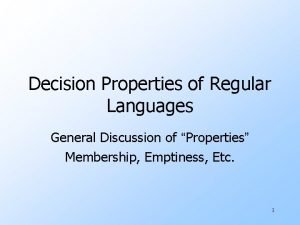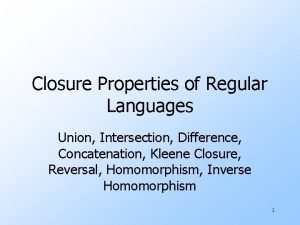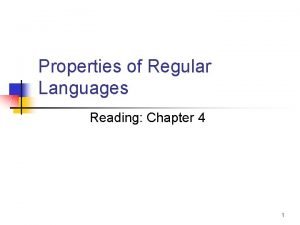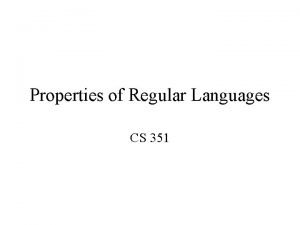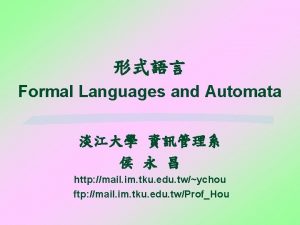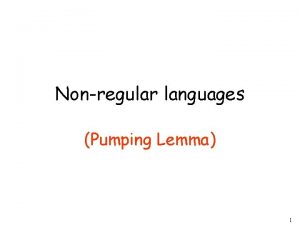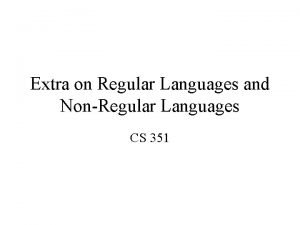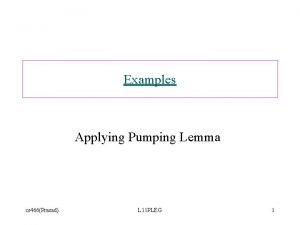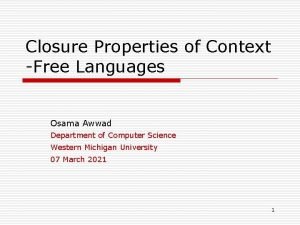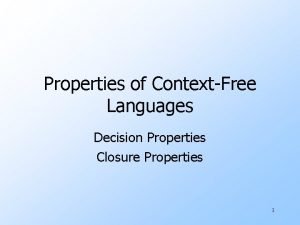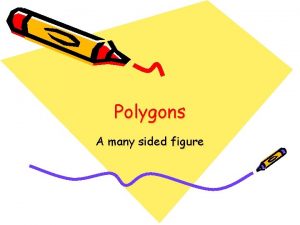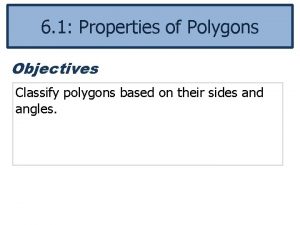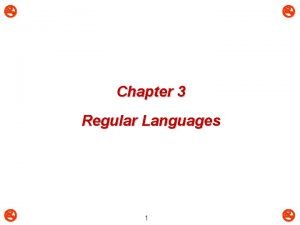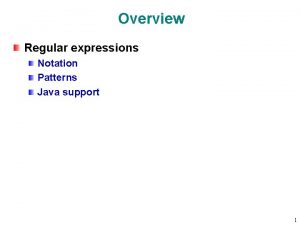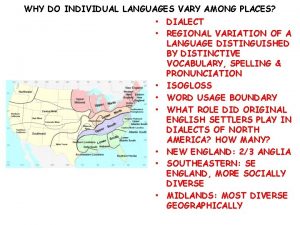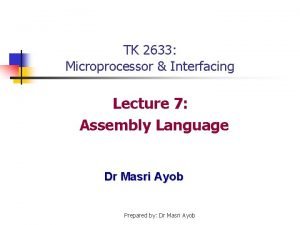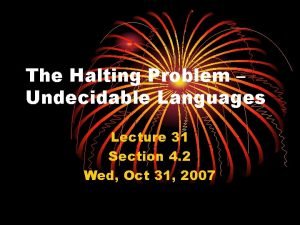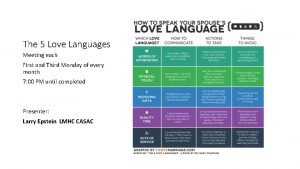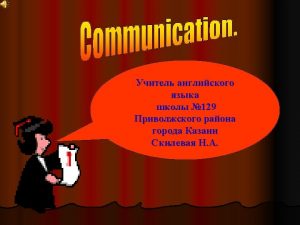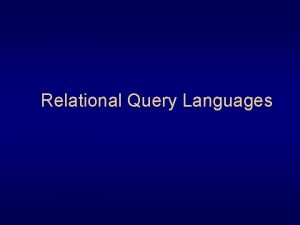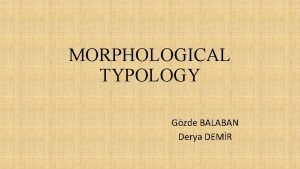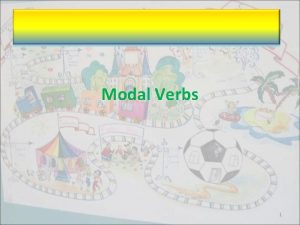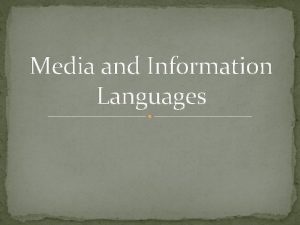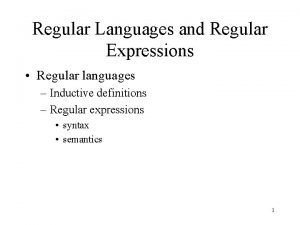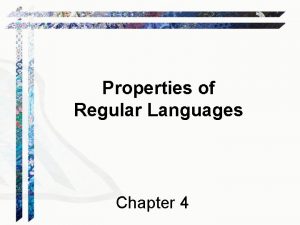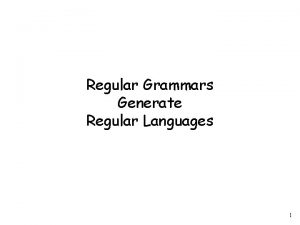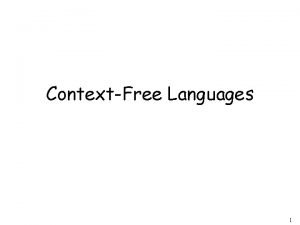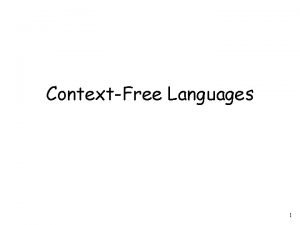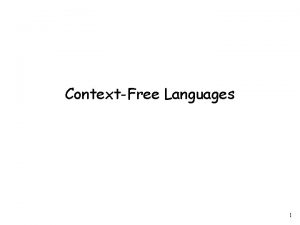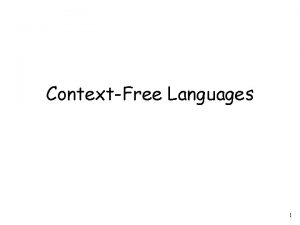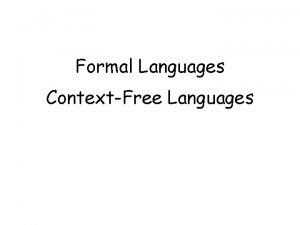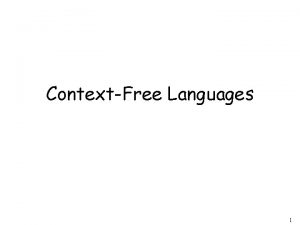Chapter 4 Properties of Regular Languages 1 4













































- Slides: 45

Chapter 4 Properties of Regular Languages 1

4. 1: Closure Properties of RLs (1) m A language L over an alphabet is regular if it q has a regular set (expression) over q is accepted y DFA, NFA, or NFA- q is generated by regular grammar 2

4. 1: Closure Properties of RLs (2) 3

4. 1: Closure Properties of RLs (3) m If L 1 and L 2 are regular languages, then q L 1 L 2 Union Ø = {w * : w L 1 or w L 2} m q L 1 L 2 Intersection q L 1 L 2 Concatenation q L* Kleene Star q L 1 Complement Ø = {w * : w L 1 and w L 2} Ø n languages: L 1 L 2 …Ln = {w 1 w 2…wn : wi Li} Ø one languages: Ln = {w 1 w 2…wn : wi L} Ø L*= L 0 L 1 L 2 … Ø L = * - L = {w : w * and w L} are also regular languages 4

4. 1: Closure Properties of RLs (4) m m Prove that RLs are closed under complementation. If L is a regular language over , then L = * - L is regular language. Proof: q If L is regular, there exists a DFA M recognizing L. q We can construct a DFA M’ for L by copying M to M’ except that all final states in M are changed to non-final, and all non-final states to final. See next slide for a formal proof 5

4. 1: Closure Properties of RLs (5) m m m m Let M 1=(Q, , , q 0, F) a DFA that accepts L(M 1) Let M 2=(Q, , , q 0, Q-F) a DFA that accepts L(M 2) Obviously both languages are regular languages Per definition 2. 2: L(M) = {w * : (q 0, w) F} The following are both true q w * : (q 0, w) F (q 0, w) Q – F q w * : (q 0, w) Q - F (q 0, w) F Thus L(M 2) = L(M 1) is an arbitrary regular language and its complement is also a regular language, therefore the regular languages are closed under complementation 6

4. 1: Closure Properties of RLs (6) m m m Are regular languages closed under intersection? If L 1 and L 2 are RLs, then L 1 L 2 is RL. Proof: q Since RLs are closed under union and complementation, they are also closed under intersection q L 1, L 2 are RLs, so L 1, L 2 are RLs, and L 1 L 2 is RL, so L 1 L 2 is RL. q Thus L 1 L 2 = L 1 L 2 is RL. 7

4. 1: Closure Properties of RLs (7) m m Are regular languages closed under difference? If L 1 and L 2 are RLs, is L 1 - L 2 RL? Why? m q q L 1 - L 2 = L 1 L 2 Since RLs are closed under intersection and complementation, they are also closed under difference. 8

4. 1: Closure Properties of RLs (8) m Let L, M and N are regular expressions, which of the followings are correct? m Commutative Rules: q L M=M L q LM = ML m Associative Rules: q (L M) N = L (M N) q (LM)N = L(MN) 9

4. 1: Closure Properties of RLs (9) m Which of the followings are correct? m Left Distributive Rules: q L(M N) = LM LN q L (MN) = (L M)(L N) m Right Distributive Rules: q (M N)L = ML NL q (MN) L = (M L)(N L) 10

4. 1: Closure Properties of RLs (10) m Identities: q is the identity for union: Ø L=L =L q is the identity for concatenation: Ø L = L 11

4. 1: Closure Properties of RLs (11) m Other Rules for Kleene Closure q q q (L*)* = L* L+ = LL* = L*L L* = L+ | *= * = 12

4. 2: Elementary Questions about RLs m Membership question: q If L is a RL over , then for any string w * there exists an algorithm for determining whether or not w is in L. Ø DFA m Empty, finite, or infinite question: q There exists an algorithm for determining whether a RL is empty, finite, or infinite. Ø DFA (path from start to final, cycle) m Equality question: q If L 1 and L 2 are RLs, then there exists an algorithm to determine whether or not L 1 = L 2. Ø L 3 = (L 1 L 2) = iff L 1 = L 2 13

4. 3: Non-regular Languages (1) m The language q L = {an bn | n 0} is not regular q There is NO DFA/NFA that accepts L m Theorem: If L 1 is RL and L 2 is not-regular, then q The language L = L 1 L 2 is not necessarily regular Proof: q L 1 = a*b* is regular q L 2 = {an bn | n 0} is not regular q L 1 L 2 = L 2 which is not regular m m 14

4. 3: Non-regular Languages (2) m m The language q L = {an bm | n, m 0 and n m} is not regular. Proof: q L is regular iff L a*b* is regular. q But L a*b* = {an bn | n 0}, which we know is not regular. q Then L is not regular. 15

4. 3: Non-regular Languages (3) m Many languages are non-regular: q {anbn | n 0} q {ww. R} | w * } 2 q {an | n 0} q {ap | p is prime} q set of well-formed parentheses q set of palindromes: {w = w. R} q …. . . 16

4. 3: Non-regular Languages (4) m We want to prove that L = {akbk | k 0} is nonregular. Prove by contradiction: q q Assume that there is a DFA M which recognizes L. Let n be the no. of states in M Consider the acceptance of the input arbr where r n: q 0 a q 1 a q 2 a a qr b qr+1 b …. . . ar …. . . b q 2 r br path for accepting arbr 17

4. 3: Non-regular Languages (5) q Since r n and M has only n states, there must be at least one state visited twice in the first r transitions. Let this state be visited at the ith and the jth steps, where j i. qi = qj a path in M q 0 q q qf F By skipping the loop, ar-(j-i)br should also be accepted by M, but this is contradictory since ar-(j-i)br L 18

4. 3: Non-regular Languages (6) m 2 k {a We want to prove that L = | k 0} is nonregular. Prove by contradiction: q q Assume that there is a DFA M which recognizes L. Let n be the no. of states in M M should also accept the string an 2 q 0 a q 1 a q 2 a …. . . a q 2 n path for accepting an 2 19

4. 3: Non-regular Languages (7) q Since n 2 n and M has only n states, there must be at least two equal states from q 0 to qn 2. Let them be qi and qj where j - i = m n. A loop of length m qi = qj a path in M q 0 q qn 2 F By repeating the loop one more time, a(n 2+m) is also accepted by M, which is a contradiction, since (n 2+m) cannot be a square (the next square after n 2 is (n+1)2 but n 2+m (n+1)2) 20

4. 3: Non-regular Languages (8) m We want to prove that L = {ap | p is a prime} is non -regular. Prove by contradiction: q q Assume that there is a DFA M which recognizes L. Let n be the no. of states in M From Number Theory, we know that the no. of primes are infinite, so there exists a prime p n q 0 a q 1 a q 2 a …. . . a qp path for accepting ap 21

4. 3: Non-regular Languages (9) q Since p n and M has only n states, there must be at least two equal states from q 0 to qp. Let them be qi and qj where j - i = m 0 qi = qj A loop of length m a path in M q 0 q qp F By repeating the loop (p-m) times, a(p-m)m + (p-m) = a(p-m)(m+1) is also accepted by M, which is a contradiction since (p-m)(m+1) is not a prime, since it can be divided by (p-m) and (m+1) 1 22

4. 3: Pumping Lemma (1) m If L is a regular language, there is a DFA which recognizes L. q All finite languages are regular Ø , {a}, {abaabb, b, baabbbbb, bb} q So, only infinite languages are interesting for this discussion. m What are non-regular languages? m Pumping Lemma q A technique for proving a language L is NOT regular 23

4. 3: Pumping Lemma (2) m m m Any given DFA has a finite number of states Let k = |Q| Consider any accepted input w = a 1…an, such that |w| = n k q DFA follows a path of states q 0…qn: q 0 q q a 1 q 1 a 2 … an-1 qn-1 an qn This state numbering has nothing to do with state names in Q May repeat states in this path 24

4. 3: Pumping Lemma (3) m Since |w| k, path must contain at least one loop q Consider any one such loop (cycle) q Break string & path into three parts: before, during, & after loop aj q 0 m a 1 … ai … qi=qj ai+1 aj+1 … an qn Given other inputs, could loop an arbitrary number of times q (a 1…ai)(ai+1…aj)*(aj+1…an) also accepted 25

4. 3: Pumping Lemma (4) m m m If language L is regular, then for any w L that is longer than |Q|, there is a substring of w that can be repeated (pumped) any number of times with resulting string remaining in the language Lemma: q Let G be the state diagram of a DFA with k states. Any path of length k in G contains a cycle. Proof: q A path of length k contains k+1 nodes. Since there are only k nodes (states) in G, there must be a node, call it qi, that occurs in at least two positions in the path. The subpath from the first occurrence of qi to the second produces the desired cycle. 26

4. 3: Pumping Lemma (5) m Let G be the state diagram of a DFA with k states and let p be a path of length k. q q The path p can be subdivided into subpaths u, v, and z where p = uvz The length of uv is |uv| k, and v is a cycle 27

4. 3: Pumping Lemma (6) m m Pumping Lemma Let L be a regular language is accepted by a DFA M with k states. Let for ALL w L and |w| k. Then w can be divided into three parts, w = uvz, satisfying the following conditions: q |uv| k, q |v| 1, and q for all i 0, uviz L 28

4. 3: Pumping Lemma (7) m m m Proof: Let w L with |w| = n k where w(i) is the ith symbol of the string w. q 0 w(1) q 1 w(2) q 2 w(3) …. . . w(n) qn m m Since n k and M has only k states, there must be at least one repeated state from q 0 to qn Let qi be the first such repeated state qi q 0 a path in M 29 qn F

4. 3: Pumping Lemma (8) qi a path in M q 0 q qn F Let u be the string obtained by traversing from q 0 to qi, v be the string obtained by traversing the loop once (so |v| 1) In the traversal from q 0 to qi and then through the loop once back to qi, nothing except qi repeats, thus |uv| k By traversing the loop 0 or more times, we obtain uviz for all i 0 and they should all be accepted by the DFA, i. e. , in L. 30

4. 3: Pumping Lemma (9) m How to use pumping lemma to prove some L isn’t regular? q Lemma describes a property of regular languages. q Use proof by contradiction: If L doesn't have this property, it is NOT regular m We cannot use the pumping lemma to prove a language is regular q Since we have to check every string in L 31

4. 3: Pumping Lemma (10) m m m m We assume the given language L is regular Let n be the constant of pumping lemma Find a string w L where |w| n Divide w into 3 parts, w = uvz, where q |uv| n q |v| 1 Claim that uviz are also in L for all i Find one i such that uviz L Contradiction Only one string w is needed q do not need to consider all general cases q choose w that can led to contradiction easily 32

4. 3: Pumping Lemma (11) m Example 1: q L = {am bm | m 0} q Assume L is regular, n is the # of DFA states q Let w = anbn where |w| = 2 n n where p + j n and j 1 Ø w = ap aj an-p-j bn Øw=u v z q q u & v contain only a’s, since |uv| n Pick i = 2: Ø uv 2 z = ap aj aj an-p-j bn = an aj bn Ø uv 2 z contains more a’s than b’s, since |v| 1 Ø uv 2 z L q Contradiction and hence L is not regular 33

4. 3: Pumping Lemma (12) m Example 2: q L = {w | w {a, b}*, w has equal number of a’s and b’s} q w = an bn q Same argument as previous example m Choice of w is important q Different w’s may lead to different proofs, or none being possible Choice of i is important. q Different i’s may lead to different proofs, or none being possible m 34

4. 3: Pumping Lemma (13) m Example 3: q L = {(ab)i | i 0} q L is regular: L = (ab)* Ø i. e. , for any w, there is some split u, v, z that allows pumping 35

4. 3: Pumping Lemma (14) m m m Example 4: Prove that the language L of well-formed parentheses is non-regular Assume L is regular and let n be the constant of pumping lemma Let w = (n)n L, |w| = 2 n n q we do not need to consider other possible cases like ()() q we only need to ensure |w| n Then w = (m (j (n-m-j )n where j 1 and m + j n u v z 36

4. 3: Pumping Lemma (15) m By pumping lemma, (m(ji(n-m-j )n = (n+j(i-1) )n L for all i m When i = 0 (n-j )n L q since j 1 n-j n m Contradiction m We can choose i = 2, i = 3, . . . q but cannot choose i = 1 L is not regular 37

4. 3: Pumping Lemma (16) To prove L is regular m 1. Constructing a FSA (NFA or DFA), RE, or RG for L m 2. Using closure property of regular sets q Let ⊕ be a binary operation (such as union, concatenation and intersection) ØL 3 = L 1 ⊕ L 2 is regular, if both L 1 and L 2 are regular q Let ⊡ be an unary operation (such as complementation and Kleene star) Ø L 1 = ⊡ L 2 is regular, if L 2 is regular 38

4. 3: Pumping Lemma (17) Example m Prove that L is regular, where L is the set of all strings with three consecutive 0's and = {0, 1} q Let L 1 = (0 | 1)*, which is regular and L 2 = 000, which is also regular q then L = L 1.L 2.L 1 q Hence L is regular due to the closure property of regular sets under concatenation. 39

4. 3: Pumping Lemma (18) Prove L is not regular m 1. Using Pumping Lemma m 2. Using closure property of regular sets q Let ⊕ be a binary operation (such as union, concatenation and intersection) Øif L 3 = L 1 ⊕ L 2 and L 1 is regular and L 3 is not regular, then L 2 must be non-regular q Let ⊡ be an unary operation (such as complementation and Kleene star) Øif L 1 = ⊡ L 2 and L 2 is not regular, then L 1 is non-regular 40

4. 3: Pumping Lemma (19) m L = {w {a, b}*, w has equal number of a’s and b’s} q Consider q By L’ = L a*b* = {an bn | n 0} closure properties of RLs: Øif L is regular, then L’ is also regular ØBut since L’ not regular, so L can’t be regular 41

4. 3: Pumping Lemma (20) Example m Prove that L is not regular, where L is the set of all strings over {a, b} such that the number of b is the double of the number of a. Let q L 1 = (anb 2 n) , which is non-regular, and L 2 = a*b*, which is regular q then L 1 = L L 2 q By closure properties of RLs: Øif L is regular, then L 1 is also regular ØBut since L 1 not regular, so L can’t be regular 42

4. 3: Pumping Lemma (21) Common Mistakes m Let L 1 regular language, L 3 and L 4 are not regular. m Is L regular? q L = L 1 ⊕ L 3 Ø 0 n 1 n = 0*1* 0 n 1 n Ø 0*1* = 0*1* 0 n 1 n q. L = L 3 ⊕ L 4 Ø 0*1* = 0 p 1 q 0 q 1 p , where p q q L 3 = L ⊕ L 4 Ø 0 n 1 n = 0*1* 0 n 1 n 43

Class Discussion m Prove that L = {ww : w (0|1)*} is non-regular m Is L = {(01)6 n : n 0} regular? m Is L = {(ab)n : n 0} regular? 44

Summary m We use the Pumping Lemma to prove a language is not regular q Note, does not work for all non-regular languages, though m Choosing a good string w is first key step m Choosing a good integer i is second key step m Must apply argument to all legal u, v, z 45
 Every linear grammar generates a regular language
Every linear grammar generates a regular language Decision properties of regular languages
Decision properties of regular languages Decision properties of regular language
Decision properties of regular language Closure properties of regular languages
Closure properties of regular languages Decision properties of regular languages
Decision properties of regular languages Decision properties of regular languages
Decision properties of regular languages Properties of regular languages
Properties of regular languages Closure properties of regular languages
Closure properties of regular languages Pumping lemma non regular languages examples
Pumping lemma non regular languages examples Regular and irregular languages
Regular and irregular languages Pumping lemma for regular languages
Pumping lemma for regular languages Cfg closed under intersection
Cfg closed under intersection Decision properties of cfl
Decision properties of cfl Closure and decision properties of context free languages
Closure and decision properties of context free languages Decision properties of context free languages
Decision properties of context free languages Regular pentagon properties
Regular pentagon properties Regular pentagon properties
Regular pentagon properties Algebraic properties of regular expression
Algebraic properties of regular expression Regular language properties
Regular language properties Scientific notation regex
Scientific notation regex Difference between intensive and extensive properties
Difference between intensive and extensive properties Physical property and chemical property
Physical property and chemical property How do individual use languages vary among places
How do individual use languages vary among places Assembly languages list
Assembly languages list Multithreaded languages
Multithreaded languages Turing unrecognizable languages
Turing unrecognizable languages 5 love languages test results
5 love languages test results 5 love languages test
5 love languages test Love languages descriptions
Love languages descriptions 5 love languages defined
5 love languages defined 11 official languages of south africa
11 official languages of south africa How many languages are there
How many languages are there Ror programming language
Ror programming language Roman achievements that are still used today
Roman achievements that are still used today Relational query languages in dbms
Relational query languages in dbms Real-time systems and programming languages
Real-time systems and programming languages Introduction to scripting languages
Introduction to scripting languages Cs 421 uiuc
Cs 421 uiuc Thread dalam java
Thread dalam java Languages in akwa ibom
Languages in akwa ibom New zealand national sport
New zealand national sport Flexive languages
Flexive languages Modern languages for life and work
Modern languages for life and work Carol can speak three foreign languages
Carol can speak three foreign languages What is media and information languages
What is media and information languages Love one another as i have loved you
Love one another as i have loved you

